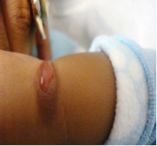Solitary Mastocytoma
The parents of this 4-month-old boy were worried about “a blister” on his wrist that had appeared suddenly the morning of the patient’s visit.
The patient had initially been seen at 6 weeks of age for a scaly, hyperpigmented, flat, velvety 1-cm lesion on the ulnar aspect of the right wrist. The lesion did not seem to bother the baby, but his mother was concerned that it had been present for about 2 weeks and had become darker and larger.
The initial diagnosis was eczema; topical emollients were prescribed. A month later, at a well-child visit, the lesion was unchanged.
A few weeks after the well-child visit, the mother noticed a firm blister in the center of the lesion that seemed to have developed overnight and that appeared to be bothering the baby. No trauma to the area was reported.

The hyperpigmented lesion measured 2 x 1.5 cm; a tense bulla was present in the center (Figures). No other skin lesions were noted. Darier sign was not elicited when the skin was stroked because of the presence of the bulla. This inflammatory reaction typically ensues in patients with mastocytosis when the skin is stroked, causing degranulation of mast cells and histamine release. A pediatric dermatologist advised that a hyperpigmented lesion with tense bulla appearing suddenly is most likely a solitary mastocytoma. One systematic review of mastocytosis notes that blistering is more common in patients with solitary mastocytoma.1
The lesion was treated with triamcinolone

acetonide 0.1% ointment, a medium potency topical corticosteroid, under occlusion. The parents were advised that resolution of the lesion might take several weeks. No further surveillance for systemic disease was suggested at that time.
Cutaneous mastocytosis
There are 4 types of cutaneous mastocytosis:
• Urticaria pigmentosa
• Mastocytoma
• Diffuse cutaneous mastocytosis
• Telangiectasia macularis eruptiva perstans
Urticaria pigmentosa is the most common. It consists of multiple red-brown macules or papules symmetrically scattered over the trunk and extremities, sparing the mouth and mucous membranes. Pruritus and dermatographism are often present. The lesions usually become more numerous and less reactive once an affected patient reaches the age of 10. Patients can have hundreds of lesions, which may become confluent. Systemic involvement is possible and most commonly involves the bones (osteoporosis or osteosclerosis), liver (hepatomegaly), spleen (splenomegaly), and GI tract (rugal thickening, malabsorption, or steatorrhea).1
A mastocytoma is a 2- to 5-cm brown or tan raised plaque, occasionally yellowish or pink, found almost exclusively in children. These lesions usually appear at birth or within a few weeks. Solitary lesions are most common, but 3 or 4 lesions may be present-usually on the trunk, neck, and arm (especially near the wrist). Multiple lesions seldom develop simultaneously.2 Lesions may be annular or linear with a smooth or “peau d’orange” surface and a rubbery consistency on palpation. Darier sign can often be elicited, and bullae may develop. Associated systemic symptoms include flushing (facial or generalized) and colic.3 These systemic signs may indicate a worse prognosis.
Diffuse cutaneous mastocytosis usually presents in patients younger than 3 years as a generalized orange-yellow-brown discoloration of the skin-often described as a thickening of the skin, or a “peau d'orange” appearance. In neonates, this variant may present as bullous lesions without macular, papular, or nodular pigmented lesions present. In nenoates, bullous lesions may be associated with systemic mastocytosis and a poorer prognosis. Patients with bullae of later onset have a better prognosis.
Telangiectasia macularis eruptiva perstans, the rarest form of cutaneous mastocytosis, usually presents as multiple telangiectatic, reddish brown macules on the trunk in adults. In some cases an isolated mastocytoma may present with numerous episodes of blistering in the first year of life. Episodes of urtication may become progressively less severe in subsequent years, only to disappear eventually completely.3
Diagnosis is usually clinical, although the serum tryptase level (an indicator of elevated mast cells) can be checked if diagnosis is uncertain. The prognosis for children with a solitary mastocytoma is good: most of these lesions resolve within several years. Topical corticosteroids are typically used until regression of the blister. Treatment is otherwise symptomatic; antihistamines directed toward H1 receptors are used primarily to combat pruritus.
References:
References:
1. Fleisher G, Ludwig S. Textbook of Pediatric Emergency Medicine. 6th ed. New York: Lippincott Williams & Wilkins; 2010:1227.
2. Cather JC, Menter MA. Red-brown skin lesions and pruritis. Proceedings (Bayl Univ Med Cent). 2000;13:297-299.
3. Bonifazi E, Garofalo L, Mazzotta F, Ciampo L. Mastocytosis. Eur Pediatr Dermatol. 1999;401-416.
Newsletter
Access practical, evidence-based guidance to support better care for our youngest patients. Join our email list for the latest clinical updates.